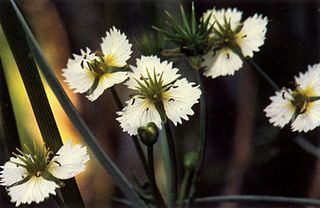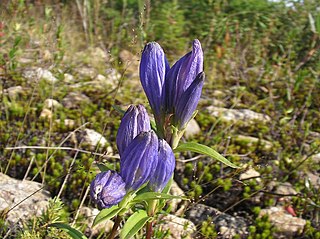
Gelsemium sempervirens is a twining vine in the family Gelsemiaceae, native to subtropical and tropical America: Honduras, Guatemala, Belize, Mexico, and southeastern and south-central United States. It has a number of common names including yellow jessamine or confederate jessamine or jasmine, Carolina jasmine or jessamine, evening trumpetflower, gelsemium and woodbine.

Gentiana andrewsii, the bottle gentian, closed gentian, or closed bottle gentian, is an herbaceous species of flowering plant in the gentian family Gentianaceae. Gentiana andrewsii is native to northeastern North America, from the Dakotas to the East Coast and through eastern Canada.

Ostrya virginiana, the American hophornbeam, is a species of Ostrya native to eastern North America, from Nova Scotia west to southern Manitoba and eastern Wyoming, southeast to northern Florida and southwest to eastern Texas. Populations from Mexico and Central America are also regarded as the same species, although some authors prefer to separate them as a distinct species, Ostrya guatemalensis. Other names include eastern hophornbeam, hardhack, ironwood, and leverwood.

Gentianella is a plant genus in the gentian family (Gentianaceae). Plants of this genus are known commonly as dwarf gentians.

Gentiana clausa, one of several plants with the common name "bottle gentian", is a 1'–2' tall flowering plant in the Gentianaceae family. It is native to Eastern North American moist meadows and woods at higher elevations, from Quebec in the north, through the Appalachian range to North Carolina and Tennessee in the south. It has paired, lanceolate leaves, usually on unbranched stalks, and blue blooms which remain closed or nearly so. It flowers from late August to October.

Symphyotrichum laeve is a flowering plant native to Canada, the United States, and Coahuila (Mexico). It has the common names of smooth blue aster, smooth aster, smooth-leaved aster, glaucous Michaelmas-daisy and glaucous aster.

Damasonium californicum is a species of perennial wildflower in the water plantain family which is known by the common name fringed water-plantain, or star water-plantain.

Gaillardia aristata is a North American species of flowering plant in the sunflower family, known by the common names common blanketflower and common gaillardia. This perennial wildflower is widespread across much of North America, from Yukon east to Québec and south as far as California, Arizona, Illinois, and Connecticut, although it may be naturalized rather than native in parts of that range. It is also naturalized in scattered locations in Europe, Australia, and South America.

Gentianopsis is a genus of flowering plants in the gentian family known commonly as fringed gentians. These are similar to the gentians of genus Gentiana. Most have flowers which are blue to purple in color. They may be annual or perennial. They are native to Eurasia and temperate North America.

Ribes aureum, known by the common names golden currant, clove currant, pruterberry and buffalo currant, is a species of flowering plant in the genus Ribes native to North America.

Lasthenia californica is a species of flowering plant in the family Asteraceae known by the common name California goldfields. It is native to western North America.

Opuntia humifusa, commonly known as the devil's-tongue, eastern prickly pear or Indian fig, is a cactus of the genus Opuntia present in parts of the eastern United States and northeastern Mexico.

Luzula multiflora, the common woodrush or heath wood-rush, is a species of flowering plant in the rush family.

Iris virginica, with the common name Virginia blueflag, Virginia iris, great blue flag, or southern blue flag, is a perennial species of flowering plant in the Iridaceae (iris) family, native to central and eastern North America.

Gentiana linearis, the narrowleaf gentian, is a 1–2 ft (30–61 cm) tall flowering plant in the Gentianaceae family. It is native to northeastern North America from Manitoba to Maine, and to the Appalachian Mountains of West Virginia, Virginia, and Tennessee. Similar to the "bottle gentians" like Gentiana clausa and Gentiana andrewsii, it has paired, lanceolate leaves, usually on unbranched stalks, and blue or purple blooms which remain closed or nearly closed; the leaves are narrower however, as the specific name indicates.

Gentiana saponaria, the soapwort gentian or harvestbells, is a 1–2 ft (30–61 cm) tall flowering plant in the Gentianaceae family.

Gentiana puberulenta, the downy gentian, is a branchless perennial plant of the Gentianaceae family native to North America. It is about ¾–1½' tall, with bright blue to deep blue-violet bell-shaped, upright, five-lobed flowers measuring 1½ to 2¼ inches across when fully open. Flowers grow in clusters of 1–8 at the apex of the plant. Lanceolate, sessile, glossy leaves up to 3" long and 1¼" across are arranged oppositely along the central stem, except at the apex where they grow in whorls of 3–7. Gentiana puberulenta grows in dry upland prairies and woods and rocky open slopes.

Gentianopsis virgata, commonly known as lesser fringed gentian, narrow-leaved fringed gentian, or smaller fringed gentian, is a biennial herbaceous species of plant, native to eastern USA and eastern Canada.

Triosteum perfoliatum, commonly known as perfoliate tinker's-weed, late horse gentian, common horse gentian, perfoliate-leaved horse-gentian, feverwort, and wild coffee, is a species of flowering plant belonging to the family Caprifoliaceae (honeysuckle). It is found in eastern and central North America. The yellow-orange berries can be dried, roasted, ground, and used as a coffee substitute.



















